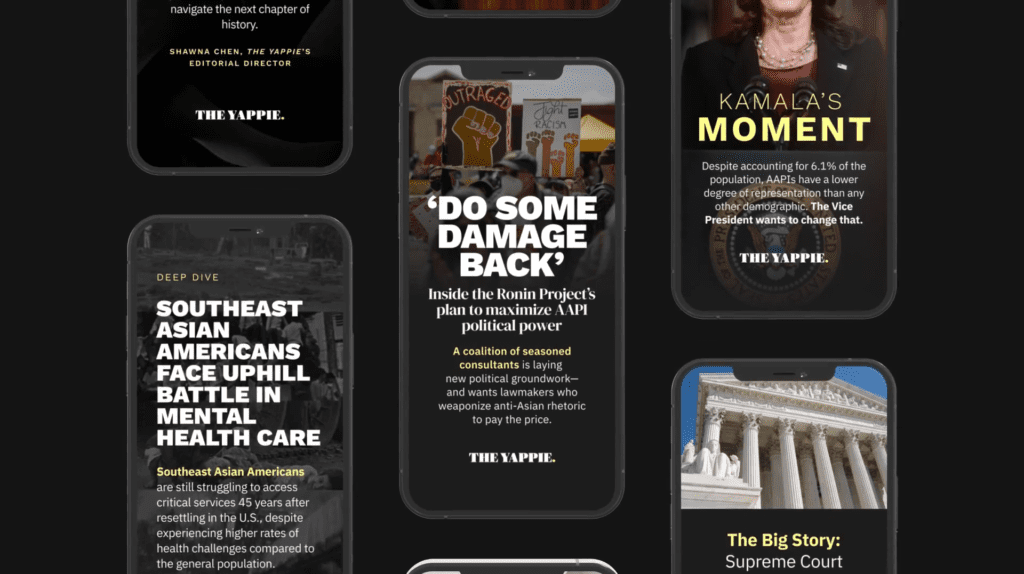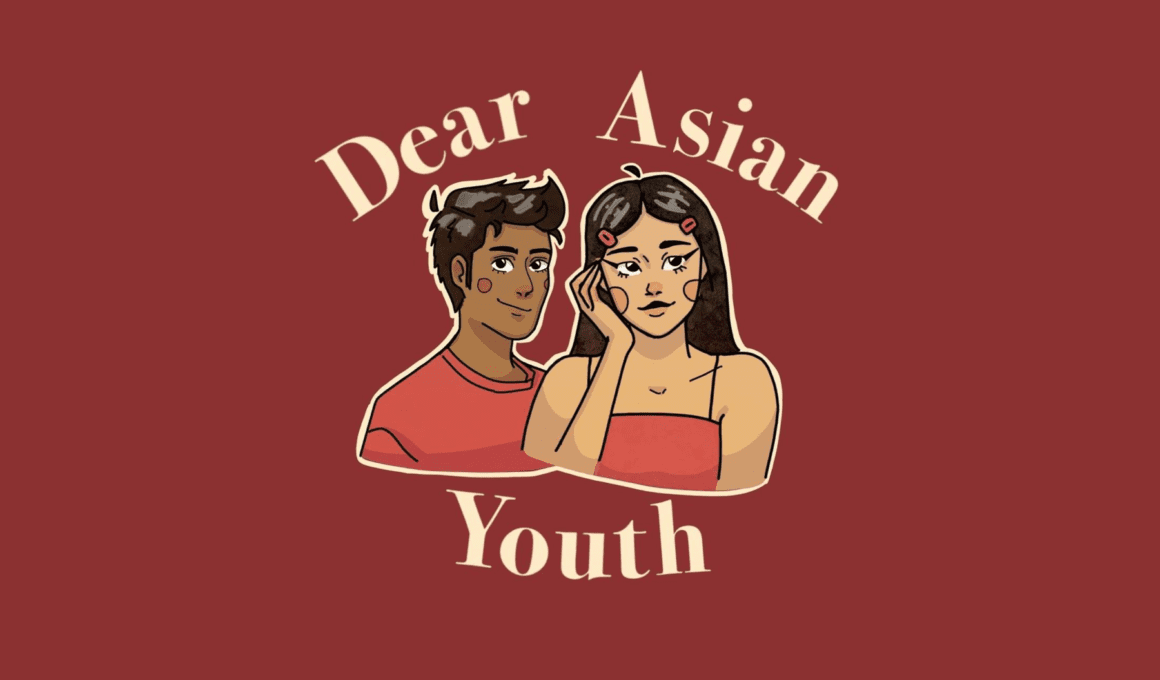Welcome to the fourth installment of The Yappie’s series featuring Asian American and Pacific Islander (AAPI) newsmakers, rising candidates, and lawmakers. If you’re interested in being featured, please email [email protected].
“Dude, it’s like my freaking whole life.”
17-year-old Stephanie Hu, half-serious and half-wry, doesn’t hold back when she describes the process of running Dear Asian Youth.
She’s not exaggerating. Dear Asian Youth (DAY for short)—at once a teen-led, Asian American Pacific Islander (AAPI)-centric social justice platform, a rapidly growing Instagram account (@dearasianyouth) with well over 90,000 followers and a burgeoning literary-magazine-turned-media-organization—is an enormous undertaking propped up, I suspect, in part by sheer willpower.
On Instagram, social activism-focused posts on topics such as defunding the police and Asian-Black solidarity are published every few days, often garnering tens of thousands of likes. The organization boasts over 100 local chapters in 17 countries, crisscrossing from Chicago and Atlanta to Seoul—not to mention some 150 members on the national team in charge of writing, design, finance, and more. Dear Asian Youth also organizes panels and events spanning everything from Asians in literature to informal, freeform “Boba Chats.”
The scope of the operation is disorientingly vast. While doing background research, I kept stumbling upon new branches of the organization—a Discord channel here, a podcast series there. Even more remarkable is the fact that all of this is barely a year old: Dear Asian Youth was established in March 2020.
It’s Hu, the organization’s founder and director, who’s leading the charge from her perch in her Mission Viejo, California bedroom.
“Our name is Dear Asian Youth because our audience is the Asian youth,” Hu told me. “The literature we produce are aimed mainly towards Asian youth [and] to empower Asian youth. But also with our narratives and opinion articles, [we] share the Asian narrative and different problems of global significance.”
In light of recent spikes in anti-Asian hate incidents—as well as the shootings that left six Asian women dead—Dear Asian Youth’s work has taken on new significance.
“Anti-Asian violence isn’t anything new,” Hu said. “COVID-19 has allowed for non-Asians to use Asian people as scapegoats, but underlying anti-Asian sentiment has always existed.”
There’s no better platform than Dear Asian Youth to address the issue: a recent post on Dear Asian Youth Literature, a subsidiary account of the organization, condemned the Atlanta shootings as “a sign that white supremacy is still alive and well.”
“This is not at all an isolated incident,” the post, which Hu helped draft, continues. “Everything, from the violence that occurred to the response by law enforcement, follows a deep history of xenophobia, racial scapegoating, sexism, and the justification and normalization of the fetishization of Asians—especially of Asian women in the U.S. Make no mistake—this violence was racially motivated.”
Dear Asian Youth has been beating the drum on this message for months now. A post released on DAY’s main account well before the shootings occurred garnered 118,000 likes, far surpassing the usual 10,000 to 20,000 likes on other posts.
“People have used and will continue to use COVID-19 as an excuse to commit violence against Asian people unless we speak up and take action now,” the post reads. “These are not isolated incidents.”
In many ways, it’s youth-led organizations like Dear Asian Youth that have elevated conversations about racism and sexism to the forefront of social media. But that wasn’t necessarily the goal when Hu first founded the platform.
The idea for Dear Asian Youth originated, according to Hu, in “a very spontaneous process.” At first, Hu wanted a place to publish her poetry. “A lot of the pieces that I write in general, like op-eds and everything, were very much related around my Asian identity,” Hu said. “Then my friends started to take interest in [the idea], and then I started to be like, this could potentially turn into something really cool, where we could just publish issues about Asian identity, because I haven’t really seen a platform dedicated to that, especially for Asian youth.”
The project grew quickly from there. “From just purely focusing on literature and more blog-related posts, [DAY] expanded to different departments; we started pioneering our podcast [and launched] Dear Asian Girls; we started to push out webinars and virtual events,” Hu told me.
Coming up with a name crystallized the project’s focus. “I know that I was toying around with a bunch of names,” Hu said. “But eventually, we made it into Dear Asian Youth. Because we were starting off centered around literature, an idea I had was we could start off every single post with ‘Dear Asian Youth.’ It was like a letter dedicated to Asian youth, basically communicating that yes, this platform is for you, and it’s a safe space for you.”
Much has already been written about social media’s power to create viral, short-lived memes and sensations in the blink of an eye. At the same time, it has also gifted activist platforms like DAY staying power and unprecedented audience growth. When I first spoke with Hu in early February, DAY’s Instagram account was just shy of 60,000 followers. A month later, the follower count had jumped to 83,000.
“We would take a picture every time we hit a new milestone,” Hu told me. “So we’d be like, ‘Oh, my gosh, 1,000 [followers on Instagram], oh my gosh, 2,000. Wow.’ I remember there was a period of time when we were really getting a ton of attention; there were tens of thousands of likes on every single post … It was like adrenaline pumping every single day.”
"Social media, yada, yada, yada"
With its graphics- and photo-heavy content, easy resharing features and general ubiquity, Instagram seems to offer a seamless platform for Dear Asian Youth. But Hu referred to the platform with more than a hint of derisiveness: she called it “the power of social media, yada, yada, yada.”
The dismissiveness is valid. Instagram slideshows, which can only pack in so much information, are hit-or-miss when it comes to fact-checking for accuracy, let alone contextualizing ideas with nuance. Topics as complex as the pervasiveness of systemic racism and the model minority myth, for instance, aren’t easily explained in a set of 1024×1024 pixel graphics.
There’s also a general lack of accountability when it comes to the creators of social justice slideshows—the account @feminist, which boasts 6.3 million followers, was run at one point by two cisgender white men. (The account’s current owner remains unclear, though the account now lists three women curators in its bio.)
For its part, Instagram and its parent company Facebook have encouraged activism. In early June, as Black Lives Matter protests swept across the country, Instagram added an “Act for Racial Justice” notification at the top of users’ feeds and published a resource guide linking to social justice posts from Black creators. Instagram has also voiced support for Asian Pacific American (APA) activism more recently.
“We’re proud to be a virtual home for the APA community to come together for solidarity, support, creativity, and connection,” a Facebook company spokesperson said in a statement. Yet neither the tech giant—nor anyone else—has an easy fix for a situation Terry Nguyen summed up in an August 2020 Vox article.
“The intent, identity of the creator, and accuracy of these [activism] guides matter a great deal,” Nguyen wrote. “But more often than not, that nuance is lost on the average Instagram user—flattened into a quick share or repost with a hasty tag as they scroll on and on.”
Hu, of course, is well aware of such limitations, and considers infusing complexity and nuance into DAY content an ongoing effort—like broadening definitions of the Asian diaspora.
“We realized that a lot of the content that we posted up, especially on social media, was very centered on East Asian and Southeast Asian issues,” Hu told me. “That was because our social media team had primarily been East Asian and Southeast Asian. We realized that, ‘Oh shoot, we need to be inclusive of all of Asia so this can be a safe space for everyone.’”
These days, a recent DAY Instagram post reads “The ‘Middle East’ is Asia,” while another debunks misconceptions about fashion in West Asia—in countries such as Turkey, Yemen, and Armenia.
But it’s also important to DAY to avoid perpetuating “performative activism,” Hu said, which can occur when users repost social justice posts without taking meaningful action.
“Performative activism can be very much prevalent on social media, especially if you are sharing graphics on your story but you don’t apply that to real life,” Hu said.
In that context, Dear Asian Youth’s decision to “not only be a social media-based organization,” as Hu explained to me, is easy to understand.
“Our social media is our main platform for spreading information to a large audience,” she said. “But we want to provide more beyond that. We want our activism to be deeper than that.”
That’s embedded in their DNA. Dear Asian Youth’s local chapters have spearheaded initiatives ranging from community fundraisers to get-out-the-vote campaigns. And in events such as “Boba Chats”—virtually held breakout sessions inviting participants to take center stage—individuals from “different backgrounds in different parts of the world” can engage in more “intimate conversations.”
Activism burnout is a real concern, though.
“When you’re constantly looking through infographics and you’re constantly sharing posts, digesting information, at times, it can be too much,” Hu said. “Activism is amazing, but also, we all need a break sometimes.”
That ethos is reflected in the Dear Asian Youth team. “We’re all learning, every day, on how to combat [activism burnout],” Hu told me. “We have a daily reminders channel on our Discord that is for us as directors to post wholesome messages like, ‘Hey, guys, don’t forget to drink water today. Hey, guys, make sure to take some rest.’”
Taking a stance
These days, the line between sharing news about current events and sharing reactions to such news can often blur indistinguishably. But Hu maintains that Dear Asian Youth is not a journalism publication, at least not in the traditional sense.
Yes, content is often produced in response to current events and pop culture—everything from the Myanmar coup to Rihanna’s appropriation of Hinduism—and yes, the rigorous process behind creating a post wouldn’t be out of place in a professional newsroom. (Hu places emphasis on the fact that “several lenses of people from different backgrounds,” including a Diversity and Inclusion Task Force, review each post before publication.)
“Knowledge is power,” Hu said. “Essentially, what we try to do through our Instagram posts is not only giving [readers] knowledge, but also providing them with resources that they can bring back to their own communities or resources so that they can promote change.”
But Dear Asian Youth isn’t afraid to express their well-defined stances as an organization, even (and especially) on controversial issues.
“One of the stances that we’ve taken is: we are for affirmative action,” Hu told me. “That was one [stance] that maybe would have pushed a lot of other Asian Americans away from our organization. But it is what it is. I don’t care—we’re for affirmative action.”
I wanted to know a little bit more—does Hu feel that Dear Asian Youth has an obligation to represent conservative voices in the Asian American community who might, say, oppose affirmative action?
“The short answer is no,” she replied. “We’ve made it very clear that our platform is for progressive people, and we take stances on progressive issues. Certain issues we have very, very strong opinions on. I don’t think we have really ever [published] conservative perspectives on our social media posts, just because that’s not necessarily the message that we want to spread.”
Dear Asian Youth does, however, need to straddle the line between fostering a set of shared values and avoiding the classic echo chamber effect, Hu noted.
“An echo chamber is definitely an issue of concern, not only in the DAY community, but also in the activism sphere in general,” she said. “We really tried to combat that by trying to have discussions around different issues, to make sure that we’re not only repeating the same thing without ever actually understanding it, but that we are talking about things.”
“I found a space where I feel heard”
So what’s next for Dear Asian Youth?
Hu recently pulled off a conference centering women of color, which wasco-hosted with Instagram social justice accounts Dear Asian Youth, Afro Puff Chronicles, Zenerations and Diversify Your Narrative. The event featured keynote speakers, panelists, and scholarships to promote personal and professional opportunities for women of color.
“Working with other women of color, strong women of color, to produce such a meaningful event has been extremely fulfilling and an eye-opening experience,” Hu said.
I asked her what she thought Dear Asian Youth’s proudest accomplishment has been up to this point. “I am personally just amazed by the fact that we are a group of students who are so dedicated to this, and that we’ve built a community [and] a safe space for other Asian people,” she said. “The affirmations in our own identity is something that I think will be more important than anything numerical that we can put a number to.”
17-year-old Lillian Han, the editor-in-chief of DAY’s literary magazine, agrees. “[People] tell us that we’ve made a difference in their lives,” she said. “Even among our own team members, I know that a lot of us came in kind of lost about our identity, sort of unsure about our Asian identity, and the fact that we’ve all come out more confident, more well versed in these different areas—I think that is an accomplishment in itself.”
Hu has no concrete plans further down the line, but stresses her focus on maintaining Dear Asian Youth’s mission and set of values. “I want to see our organization be as diverse and inclusive as it possibly can be,” she told me. “Obviously, there’s always more that we can work towards, and we’re very dedicated to making sure that our community can be a safe space to all Asians. We want [Asians] to be able to come to Dear Asian Youth, and instead of feeling [underrepresented] like they have been for their entire life, to finally be able to say, ‘I found a space where I feel heard.’”
When I’m talking to Hu, it’s easy to see her conviction and dedication to this idea—conviction and dedication offset, at least for now, by the trappings of her age.
“I myself am literally a high school student who has four missing assignments right now,” Hu added, laughing. “I know what it’s like to have to balance things.”
As the interview wrapped up, I asked Hu: how would she describe Dear Asian Youth in a nutshell?
Hu hesitated for a second before answering.
“I would just describe it as a youth-led organization,” she said. “We’re really youth-powered; for the youth, by the youth. There are so many components to us that it’s difficult to narrow it down to one specific thing that we are. But what we are is by Asian youth, for Asian youth.”
The Yappie is your must-read briefing on Asian American power, politics, and influence. Make a donation, subscribe, and follow us on Twitter (@theyappie). Send tips, ideas, events, job/internship postings, and projects to [email protected].









